Not all rivers are safe to swim in, so what about the Connecticut River? Despite the river’s name, it stretches through other states including Massachusetts. In this article, we are going to learn about what’s in the Connecticut River and if it’s safe to swim in.
What is the Connecticut River?
The Connecticut River is a long river in New England. It runs through Connecticut, Massachusetts, Vermont, New Hampshire, and a very small part of Maine. The river is about 410 miles long with a basin size of 11,260 square miles. This lake’s source is the Fourth Connecticut Lake, which is near the Canada-US border.
Previously, the Connecticut River was known by different names like the Fresh River, Great River, and Verse River. The word Connecticut has origins tied to the Mohegan and Nipmuc people. Native Americans have lived along the river for over 6,000 years. European explorers reached this river in the early 1600s.
The Connecticut River is divided into three sections, the Upper Connecticut River, Middle Connecticut River, and Lower Connecticut River. The Upper Connecticut River runs through Vermont and New Hampshire.

The Connecticut River is 410 miles long with a basin size of 11,260 square miles.
©Christian Hinkle/Shutterstock.com
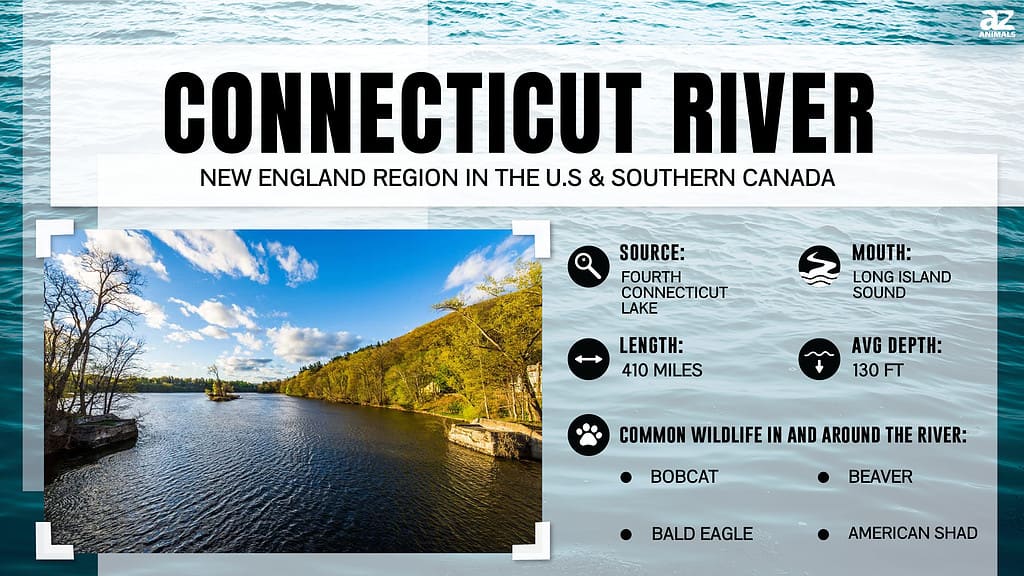
What’s in the Connecticut River?
You won’t have to worry about animals while swimming in the Connecticut River. Most of the animals in the water are harmless, even if some fish species easily weigh over 20 pounds! Interestingly, some harbor seals have also been spotted within this long river. While harbor seals are occasionally spotted here, you’re more likely to see a fish! Keep reading to discover the animals that live in this river and if they pose a danger.
Atlantic Salmon
The first animal you may encounter on our list in this river is the Atlantic salmon. They are large ray-finned fish native to the northern Atlantic Ocean and the rivers that flow to it. These fish are about 28 to 32 inches long and can weigh as much as 109 pounds! The longest Atlantic salmon ever recorded was 63.25 inches. They aren’t picky eaters. Small and young Atlantic salmon consume invertebrates, while adults feed on fish, and sometimes salmon eggs. They also eat plankton and insects.
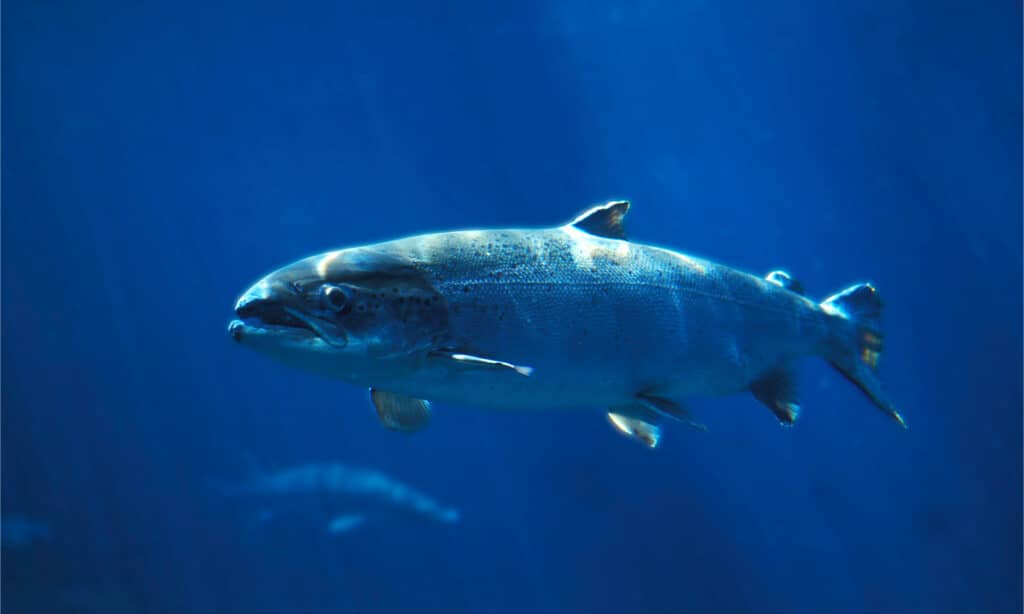
Atlantic salmon are fusiform, which means that they have a spindle-like shape.
©slowmotiongli/Shutterstock.com
Northern Water Snake
The next animal on our list is the northern water snake, a very common snake in North America. Northern water snakes are large, but nonvenomous. However, their bites still hurt and can break through the skin. They also aren’t afraid to bite repeatedly when threatened, a technique they use to get away from predators. Northern water snakes are also called common water snakes, black water snakes, and banded water snakes. They are sometimes mistaken for the venomous cottonmouth. This snake is about 4 to 5 feet long and can weigh as much as 13 ounces. They vary in color and shade but are typically yellow, red, and brown with dark markings on their bodies.
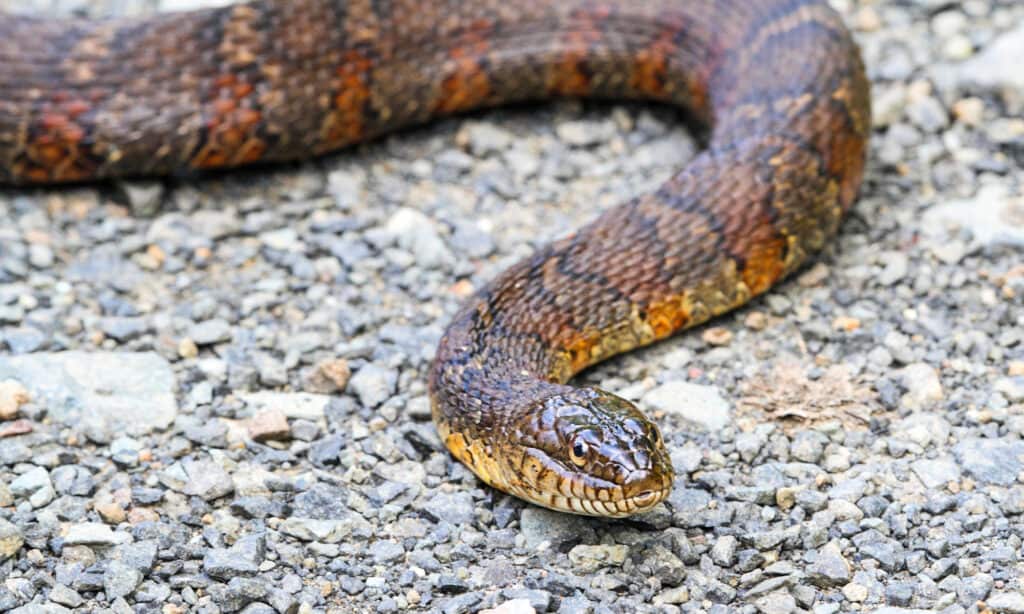
Northern water snakes are one of the most widespread water snakes in North America.
©Steve Byland/Shutterstock.com
Brook Trout
You have nothing to worry about when swimming with brook trout. While they can reach impressive sizes, these fish are harmless to humans. Brook trout are freshwater fish native to eastern Canada and the United States. Like many fish in this article, they go by many names including brook charr, mud trout, coasters, and speckled trout. Brook trout also produce hybrids. One hybrid species is called the tiger brook trout. Most brook trout weigh between 0.66 and 6 pounds.

Brook trout are harmless to humans.
©K Steve Cope/Shutterstock.com
Rainbow Trout
Apart from brook trout, you can also encounter rainbow trout in the Connecticut River. Rainbow trout are freshwater and saltwater fish. Some rainbow trout never leave rivers or lakes. They also vary in size and color. For example, freshwater rainbow trout weigh about 1 to 5 pounds. However, species that live in both saltwater and freshwater weigh 20 pounds. Rainbow trout consume aquatic insects, small fish, crustaceans, and eggs. There are also many rainbow trout subspecies. One is the Beardslee trout, which only lives in Lake Crescent in the Olympic National Park.
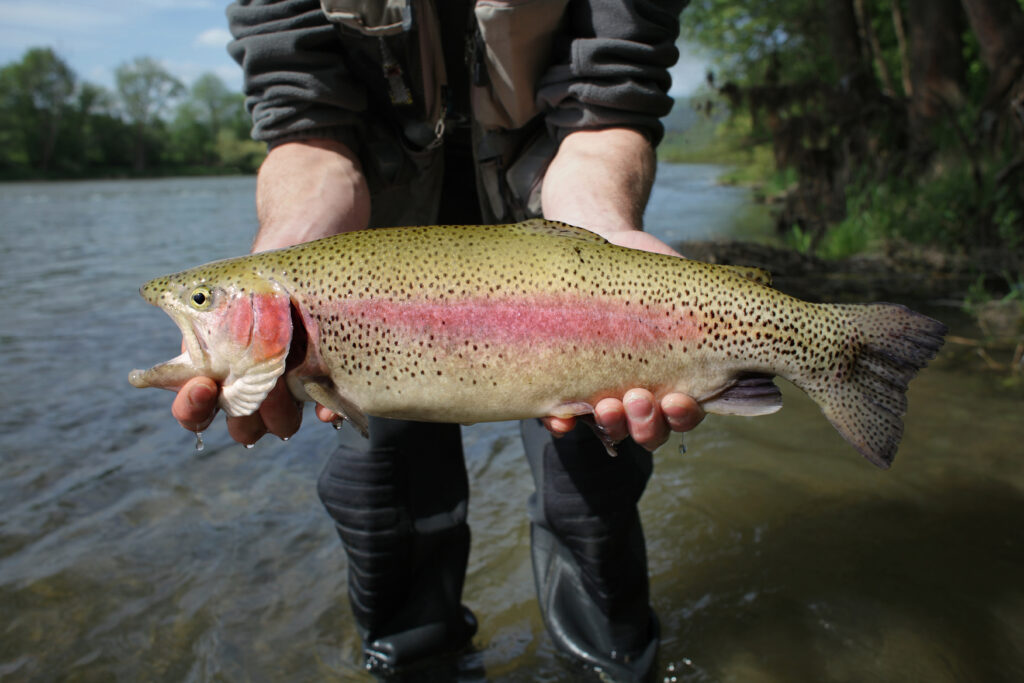
Anglers travel all over North America searching for large rainbow trout to catch.
©pictoplay/Shutterstock.com
Blueback Herring
The next fish on our list is the blueback herring, which is native to the east coast of North America. They are unique fish known by many names. Blueback herrings are also called summer shads and blueback shads. They have silverish bodies and thick scutes on their bellies. There is still a lot we are learning about blueback herrings, but scientists believe they live up to 8 years. Like other fish in the Connecticut River, they are anadromous. They migrate deep into rivers in spring to spawn. Blueback herrings reproduce quickly. Females can produce 60,000 to 103,000 eggs in their lifetime.
Rock Bass
Another animal in the Connecticut River is the rock bass. It’s native to east-central North America and goes by many names including black bass, black perch, rock perch, and red-eye. You can find these fish in many states including Florida, Tennessee, Kentucky, Georgia, Arkansas, Missouri, and Texas. Rock bass are small fish with six anal spines and red eyes. They also have small teeth and a large mouth, which sometimes causes anglers to confuse them for largemouth bass. However, rock bass only reaches about 6 to 10 inches long. They are best spotted in clear rivers with rocky bottoms and vegetation.
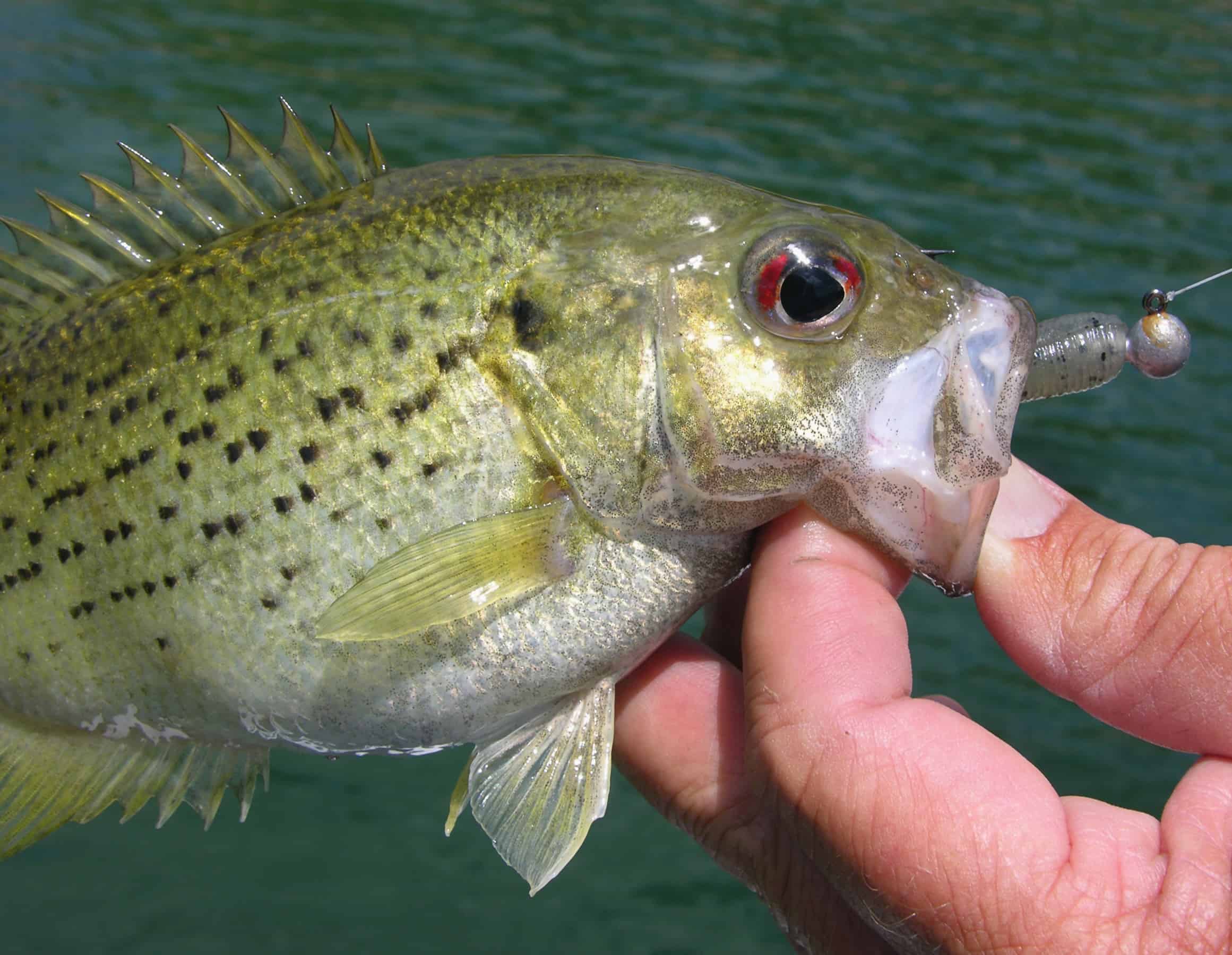
Anglers sometimes confuse rock bass with largemouth bass, but rock bass are smaller.
©Steve Brigman/Shutterstock.com
Atlantic Sturgeon
While the Atlantic sturgeon may look dangerous, this long and thick fish is harmless to humans. Like blueback herring, they are anadromous fish. Atlantic sturgeons are old fish nicknamed living fossils. Unlike other fish, Atlantic sturgeons have five rows of thick and hard scutes, which acts as protection against predators. It looks like armor. These large fish can reach 15 feet long, but more commonly measure between 6 to 8 feet. Still, this is longer than most humans! They can also weigh over 300 pounds. Although Atlantic sturgeons are mainly found in eastern North America, there is a small and nearly extinct population in the Baltic Sea. Currently, this fish species is listed as Near Threatened on the IUCN Red List and Vulnerable by NatureServe.

Atlantic sturgeons can weigh over 300 pounds.
©iStock.com/RussieseO
Pumpkinseed Sunfish
Have you ever heard of the pumpkinseed sunfish? It’s a member of the Centrarchidae family. These fish are also called sunny, punkie, sunfish, and pond perch. They are found throughout the United States. Pumpkinseed sunfish are invasive species in Europe. So, why are pumpkinseed sunfish named after pumpkin seeds? They are small fish with pumpkinseed-shaped bodies. They are also very vibrant fish with orange, green, and yellow bodies. You can easily identify a pumpkinseed sunfish by its orange-red spot. These lovely fish live in clear ponds, lakes, and rivers and find places to hide. The largest pumpkinseed sunfish ever caught weighed 1 pound and 8 ounces. Most pumpkinseed sunfish weigh less than a pound.
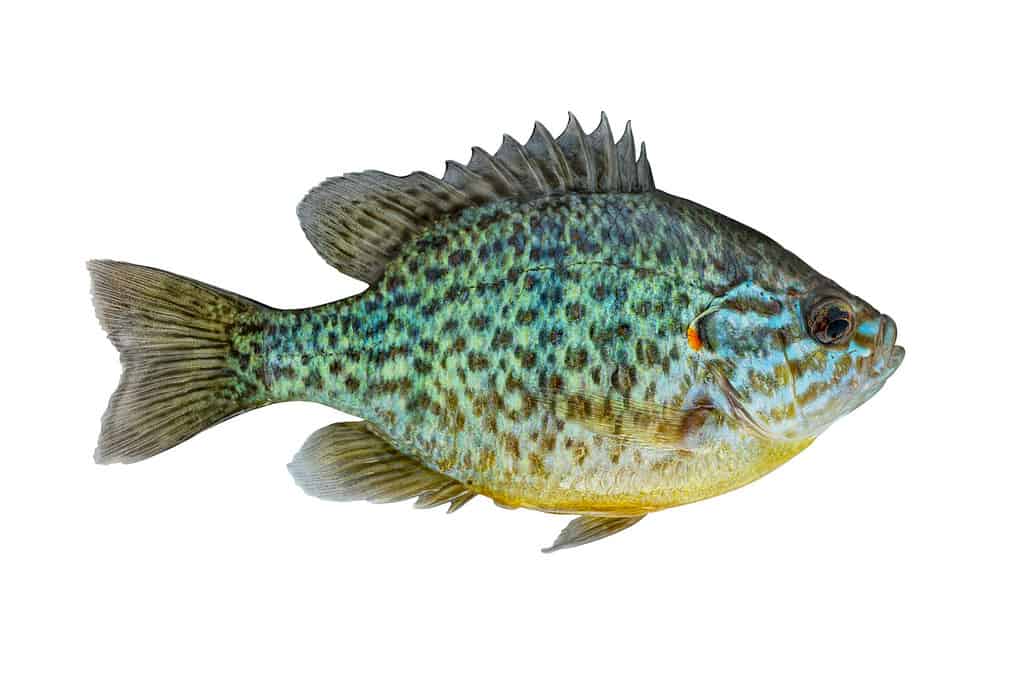
Pumpkinseed sunfish weigh less than 1 pound.
©FedBul/Shutterstock.com
Harbor Seal
Last but not least is the harbor seal, however, you’re more likely to spot the fish listed in this article. Harbor seals aren’t extremely dangerous to humans, but they are more prone to attack if they’ve associated humans with food. This is why you shouldn’t feed wild animals. Harbor seals have beautiful patterns of spots. They are about 6 feet long and weigh between 120 and 370 pounds.

Harbor seals are long and can measure up to 6 feet.
©David Pegzlz/Shutterstock.com
Can You Swim in the Connecticut River?
Now that we know what’s in the Connecticut River, we can dive into if it’s safe to swim in. In the Connecticut River, there are multiple designated swimming areas and holes. However, you should always look up advisories before visiting. Although the Connecticut River is generally safe to swim in, you should never swim in rivers after heavy rainfall. Heavy rain not only rises the water level but also increases bacteria which can infest you from a small cut.

©iStock.com/Craig Zerbe
The photo featured at the top of this post is © iStock.com/Vasili Eliopoulos
Thank you for reading! Have some feedback for us? Contact the AZ Animals editorial team.






